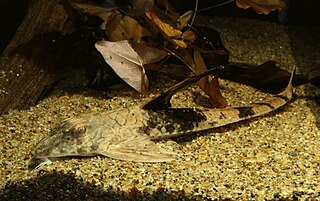
Loricariidae is the largest family of catfish, with 92 genera and just over 680 species. Loricariids originate from freshwater habitats of Costa Rica, Panama, and tropical and subtropical South America. These fish are noted for the bony plates covering their bodies and their suckermouths. Several genera are sold as "plecos", notably the suckermouth catfish, Hypostomus plecostomus, and are popular as aquarium fish.

Trichomycteridae is a family of catfishes commonly known as pencil catfishes or parasitic catfishes. This family includes the candiru fish, feared by some people for its alleged habit of entering into the urethra of humans. They are one of the few parasitic chordates. Another species is the life monsefuano which was important to the Moche culture and still an important part of Peruvian cuisine.
Listrura is a genus of pencil catfishes native to South America.

Phreatobius is a genus of very small catfishes from tropical South America.

Loricarioidea is a superfamily of catfishes. It contains the six families Trichomycteridae, Nematogenyiidae, Callichthyidae, Scoloplacidae, Astroblepidae, and Loricariidae. Some schemes also include Amphiliidae. This superfamily, including Amphiliidae, includes about 156 genera and 1,187 species.
Lithogenes is a genus of South American catfish of the family Loricariidae. It is the only genus within the subfamily Lithogeneinae.
Nannoptopoma is a small genus of catfishes of the family Loricariidae. This genus includes two species, N. spectabile and N. sternoptychum.
Stauroglanis gouldingi is a species of catfish of the family Trichomycteridae, and the only species of the genus Stauroglanis.
Glanapteryx is a genus of catfishes native to South America.
Pygidianops is a genus of pencil catfishes native to South America.
The Glanapteryginae are a subfamily of catfishes of the family Trichomycteridae. It includes four genera, Glanapteryx, Listrura, Pygidianops, and Typhlobelus.
The Sarcoglanidinae are a subfamily of catfishes of the family Trichomycteridae. It includes six genera: Ammoglanis, Malacoglanis, Microcambeva, Sarcoglanis, Stauroglanis, and Stenolicmus.
Ochmacanthus is a genus of pencil catfishes native to South America. These species are distributed in South America. O. alternus and O. orinoco originate from the Rio Negro and Orinoco River basins of Brazil and Venezuela. O. batrachstoma inhabits the Paraguay River basin in Brazil. O. flabelliferus lives in river drainages in Guyana and Venezuela. O. reinhardtii is known from the Amazon River basin in Brazil and drainages in French Guiana.

Henonemus is a genus of pencil catfishes native to South America.
The Stegophilinae are a subfamily of catfishes of the family Trichomycteridae. It includes 12 genera: Acanthopoma, Apomatoceros, Haemomaster, Henonemus, Homodiaetus, Megalocentor, Ochmacanthus, Parastegophilus, Pareiodon, Pseudostegophilus, Schultzichthys, and Stegophilus. A monophyletic group within the Stegophilinae is supported by two characteristics of the lateral line, including Acanthopoma, Henonemus, Megalocentor, Pareiodon, Parastegophilus, and Pseudostegophilus. Acanthopoma and Henonemus have a sister group relationship.
Pseudolithoxus is a genus of suckermouth armored catfishes with five described species from the basins of the Orinoco, Casiquiare and upper Rio Negro in Venezuela. Additionally, a possibly undescribed species is known from the Trombetas and Nhamundá rivers in Brazil.
The Copionodontinae are a subfamily of catfishes of the family Trichomycteridae. It includes two genera, Copionodon and Glaphyropoma.
Micromyzon orinoco is a species of catfish in the family Aspredinidae.
Ammoglanis natgeorum is a species of pencil catfish which was described from a marginal habitat of the lower Atabapo River, which is a left-bank blackwater tributary of the upper Orinoco River in Amazonas, Venezuela.
Scoloplax dicra is a species of spiny dwarf catfish found throughout the river basins of South America.




